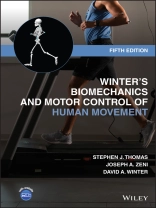An In-Depth Resource for Understanding the Foundational Concepts and Clinical Applications in the Field of Biomechanics
Winter’s Biomechanics and Motor Control of Human Movement is highly suitable as a textbook for today’s biomechanics students who may come from many diverse academic programs and professional sectors. The work covers foundational theoretical and mathematical concepts in biomechanics, as well as up-to-date data collection, interpretation, and storage techniques. It also highlights the contemporary clinical applications of biomechanical research. New case studies related to cerebral palsy, patellar femoral pain syndrome, knee osteoarthritis, and ulnar collateral ligament reconstruction are also included.
The work appeals to a broad audience within the field of biomechanics, an interdisciplinary field with applications in mechanical engineering, medicine, physical therapy, sports and exercise, and product development. Authors at leading universities guide the reader through the latest advancements in the field while also imparting critical foundational knowledge to allow for subject matter mastery and more precise practical application. Concepts covered in the book include:
* Biomechanical signal processing, anthropometry, kinematics and kinetics, muscle mechanics, and kinesiological electromyography
* Forward simulations and muscle-actuated simulations, static and dynamic balance, and the role of the central nervous system in biomechanics
* Movement sequencing and the kinetic chain concept, electromagnetic systems, inertial sensors, clinical measures of kinematics, and the advantages and disadvantages of different types of force plates
* Markerset design and event detection for gait and athletic motions like jumping, landing, and pitching
* Guidance on setting up a motion lab and access to online Excel spreadsheets with kinematic and kinetic marker data
By providing a combination of theoretical and practical knowledge, Winter’s Biomechanics and Motor Control of Human Movement will appeal to biomedical engineers working in the field of biomechanics and allied professionals in the medical, rehabilitation, and sports industries. Its comprehensive overall insight into the field of biomechanics also makes the work a highly useful resource for students and teachers of biomechanics at all levels of experience and expertise.
लेखक के बारे में
Stephen J. Thomas is Associate Professor and Chair of the Exercise Science Department at Thomas Jefferson University. His research focuses on anatomic and biomechanical adaptations to stress, particularly in the shoulder and elbow. He is a consultant for the Philadelphia Phillies at the Penn Throwing Clinic and is a Past President of the American Society of Shoulder and Elbow Therapists.
Joseph A. Zeni is Associate Professor at Rutgers University, where he teaches graduate level courses and conducts research within the Rutgers Motion Analysis Laboratory. His current work is focused on using biomechanical feedback to restore normal movement patterns after knee replacement surgery.
David A. Winter (1930-2012) was a Distinguished Professor Emeritus at the University of Waterloo and a Founding Member of the Canadian Society of Biomechanics. He pioneered many important methods and concepts in the study of human movement and balance.












